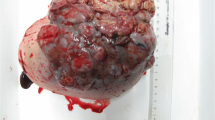Abstract
Cystic hypersecretory carcinoma (CHC) is a rare variant of intraductal carcinoma. A CHC in a 50-year-old woman was excised and processed for light and electron microscopy and immunohistochemistry. The tumor had a marked cystic appearance. The walls of the cysts consisted of epithelial and myoepithelial cells and a well-developed basement membrane. The epithelial cells contained well-developed roughsurfaced endoplasmatic reticulum and Golgi apparatus. Secretory granules were not detected, with the exception of a few mucus-producing cells. The secretion was predominantly homogenous, reminiscent of thyroid colloid, and demonstrated distinct PAS positivity. The cells displayed a strong labeling with epithelial membrane antigen (EMA) and EMA-positive structures were observed within the intraluminal secretion, too. Some of these were stained by alcian blue. In addition, the colloid-like material was admixed with mucus showing a filamentous internal structure and lipid droplets resulting in some heterogenity of the secretion. Intraductal micropapillary proliferation in some of the cysts and adjacent nondistended ducts was a further defining feature of the tumor. Steroid hormone receptor and Ki-67 proliferation marker immuno his Tochemistry showed scattered positivity among the tumor cells. These results are in agreement with previous observations and further clarify the nature of this low-grade in situ cancer.
Similar content being viewed by others
Abbreviations
- AB:
-
alcian blue
- BM:
-
basement membrane
- CHH:
-
cystic hypersecretory hyperplasia
- CHC:
-
cystic hypersecretory carcinoma
- DCIS:
-
ductal carcinoma in situ
- EM:
-
electron microscopy
- EMA:
-
epithelial membrane antigen
- FNAC:
-
fine-needle aspiration cytology
- HE:
-
hematoxylin and eosin
- PAS:
-
periodic acid Schiff
- RER:
-
rough surfaced endoplasmic reticulum
- SMA:
-
smooth muscle actin
References
Rosen PP, Scott M: Cystic hypersecretory duct carcinoma of the breast. Am J Surg Pathol 8:31–41, 1984.
Snead DRJ, Bell JA, Dixon AR, et al: Methodology of immunohistological detection of oestrogen receptor in human breast carcinoma in formalin-fixed, paraffin-embedded tissue: a comparison with frozen section methodology. Histopathol 23:233–238, 1993.
Colandrea JM, Shmookler BM, O’Dowd GJ, Cohen MH: Cystic hypersecretory duct carcinoma of the breast. Report of a case with fine-needle aspiration. Arch Pathol Lab Med 112:560–563, 1988.
Guerry P, Erlandson RA, Rosen PP: Cystic hypersecretory hyperplasia and cystic hypersecretory duct carcinoma of the breast. Cancer 61:1611–1620, 1988.
Rosen PP, Oberman HA: Cystic hypersecretory carcinoma. In: Tumors of the mammary gland. Atlas of Tumor Pathology, 3rd series, fascicle 7, AFIP, Washington, DC, 1993, pp. 226–231.
Kim MK, Kwon GY, Gong GY: Fine needle aspiration cytology of cystic hypersecretory carcinoma of the breast. A case report. Acta Cytol 41:892–896, 1997.
Author information
Authors and Affiliations
Corresponding author
Rights and permissions
About this article
Cite this article
Cserni, G., VIRÁGH, S. Immunohistochemical and ultrastructural analysis of a mammary cystic hypersecretory carcinoma. Pathol. Oncol. Res. 3, 287–292 (1997). https://doi.org/10.1007/BF02904288
Received:
Accepted:
Issue Date:
DOI: https://doi.org/10.1007/BF02904288




